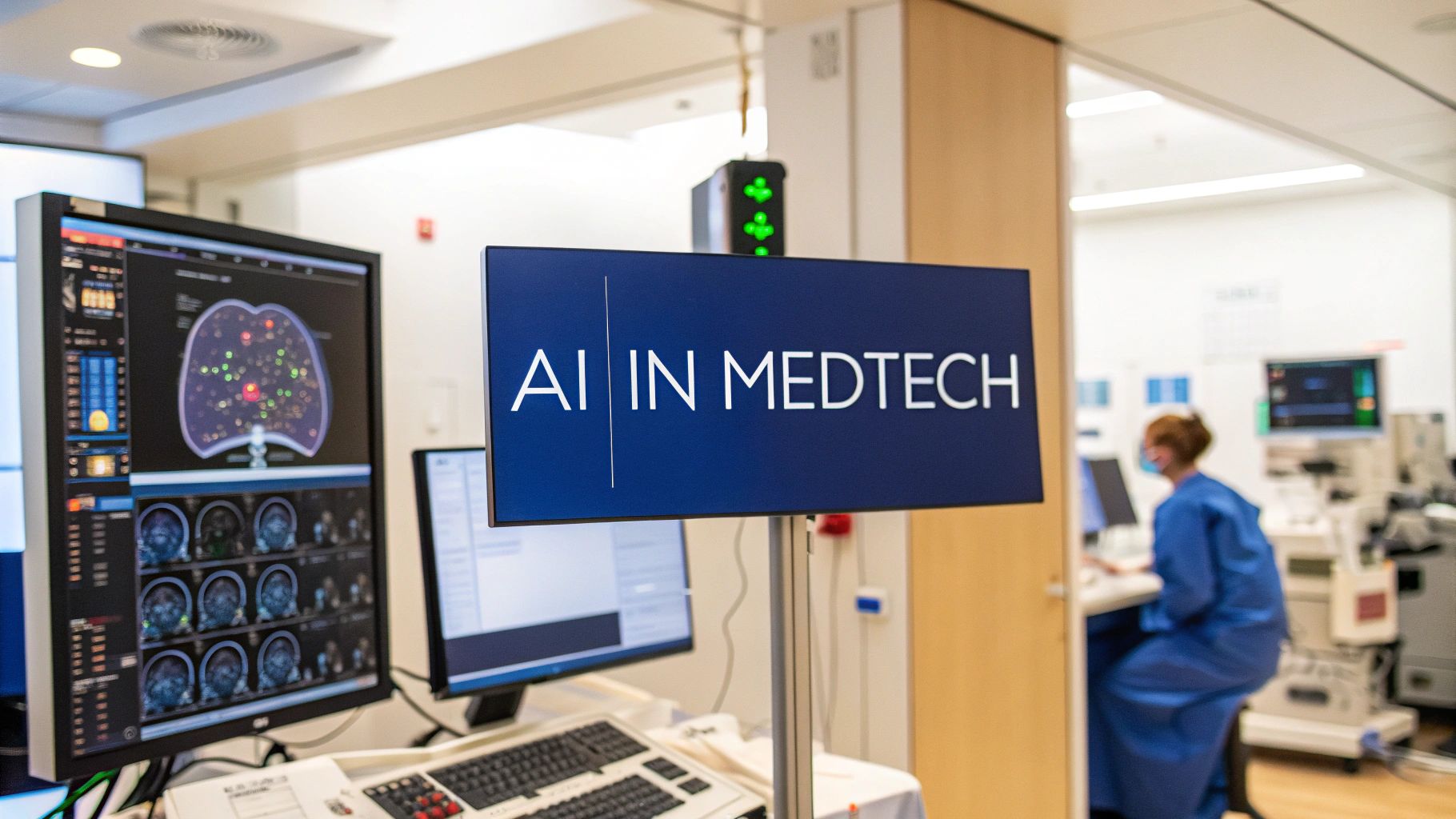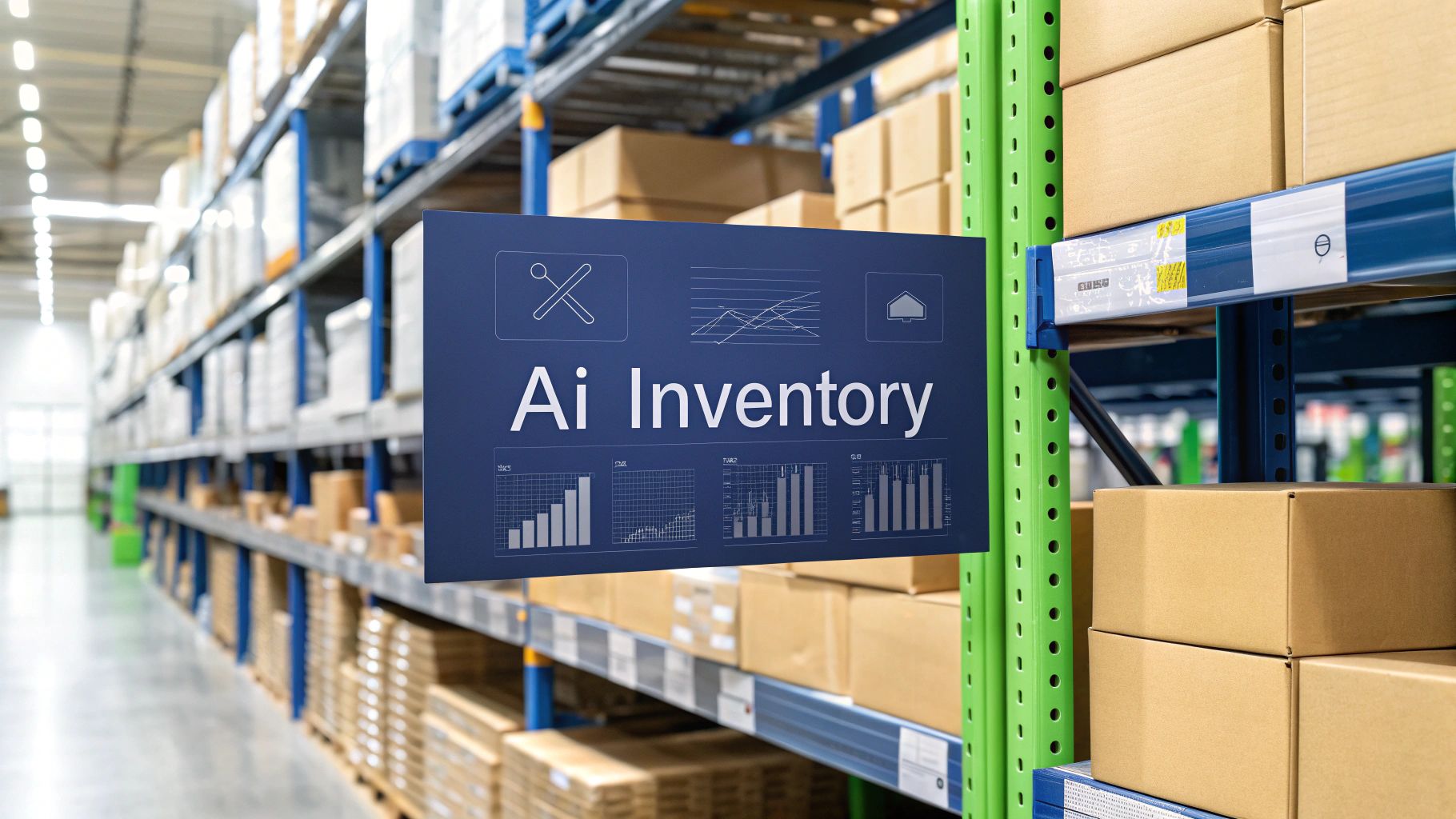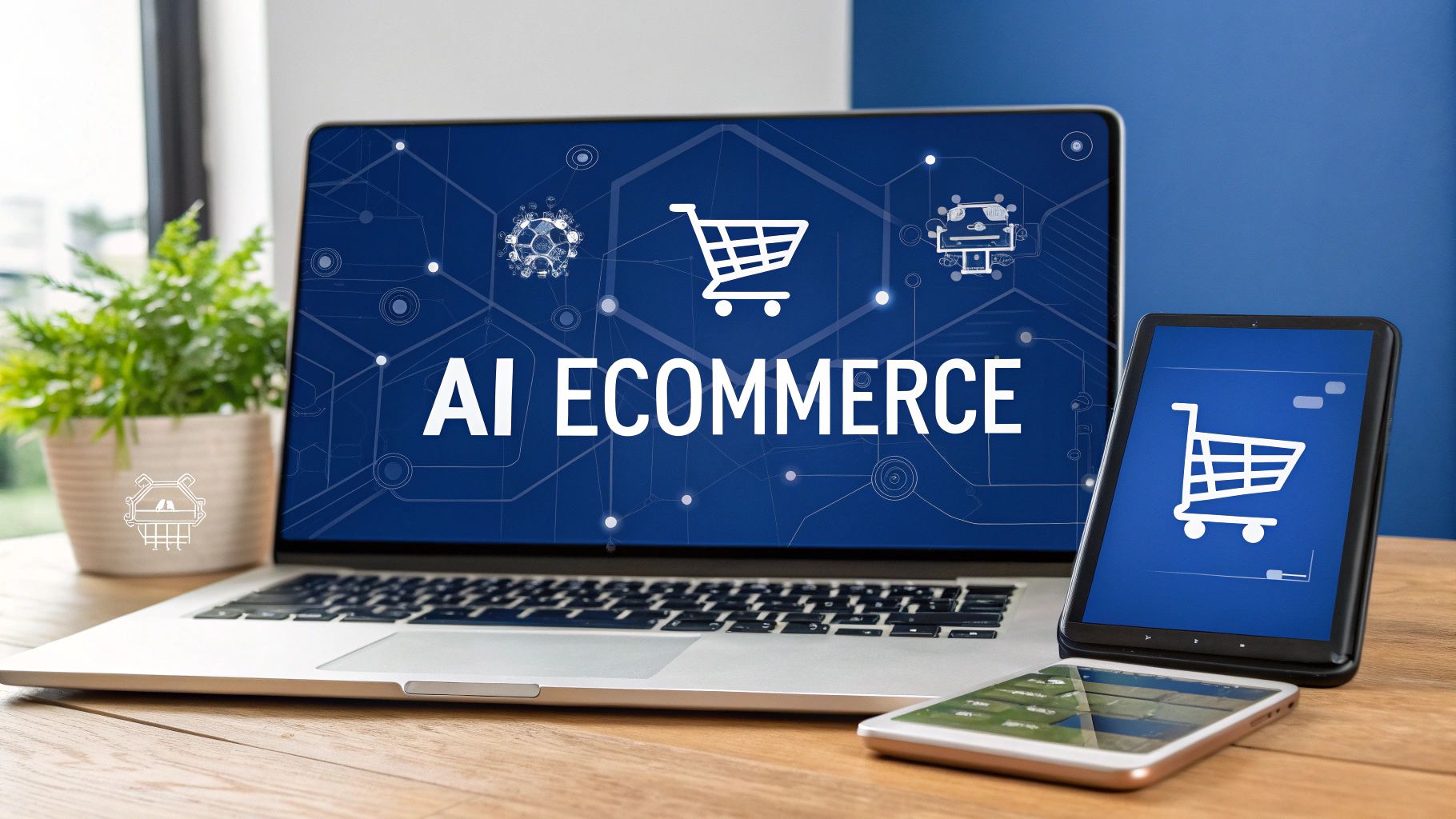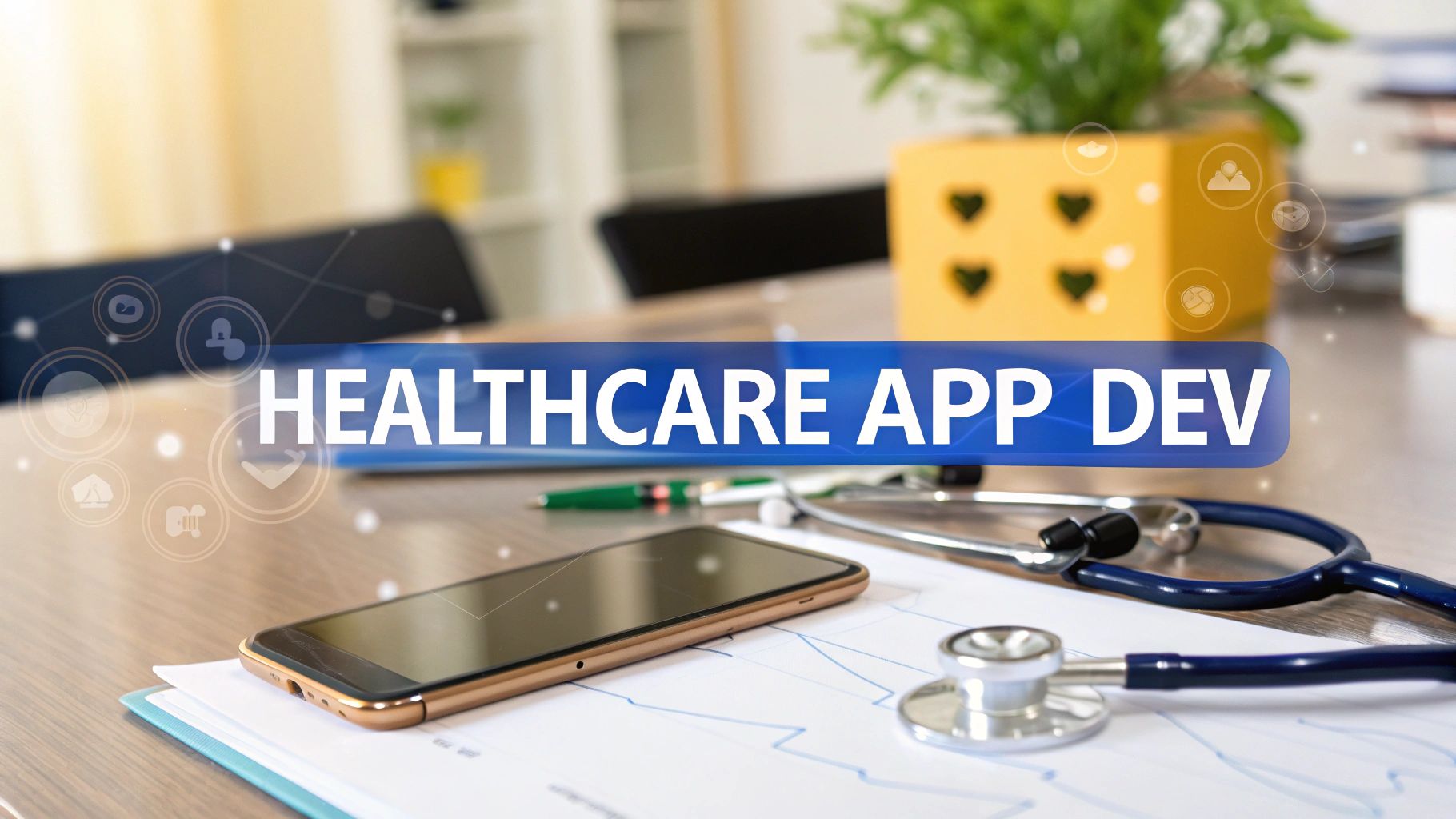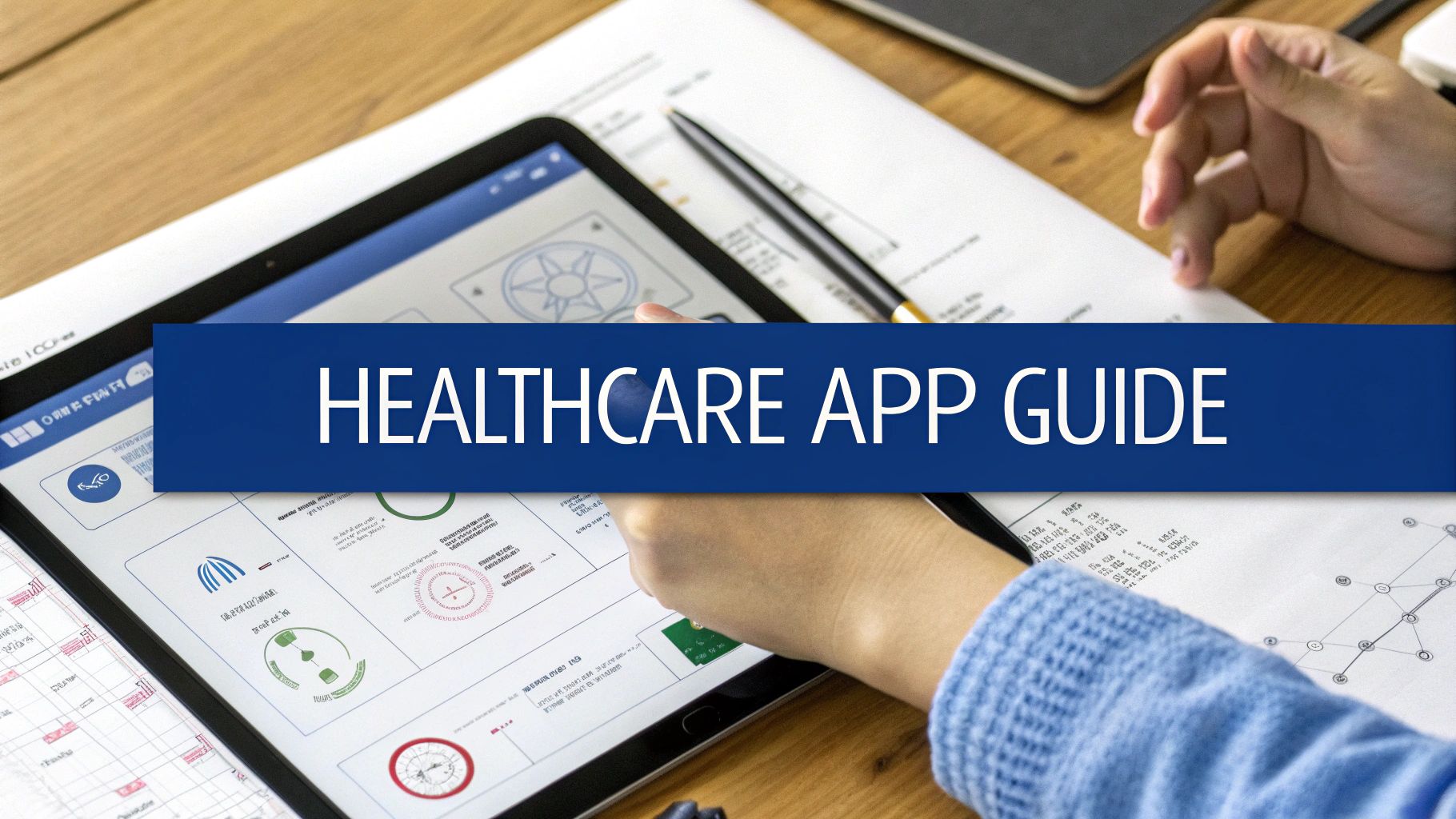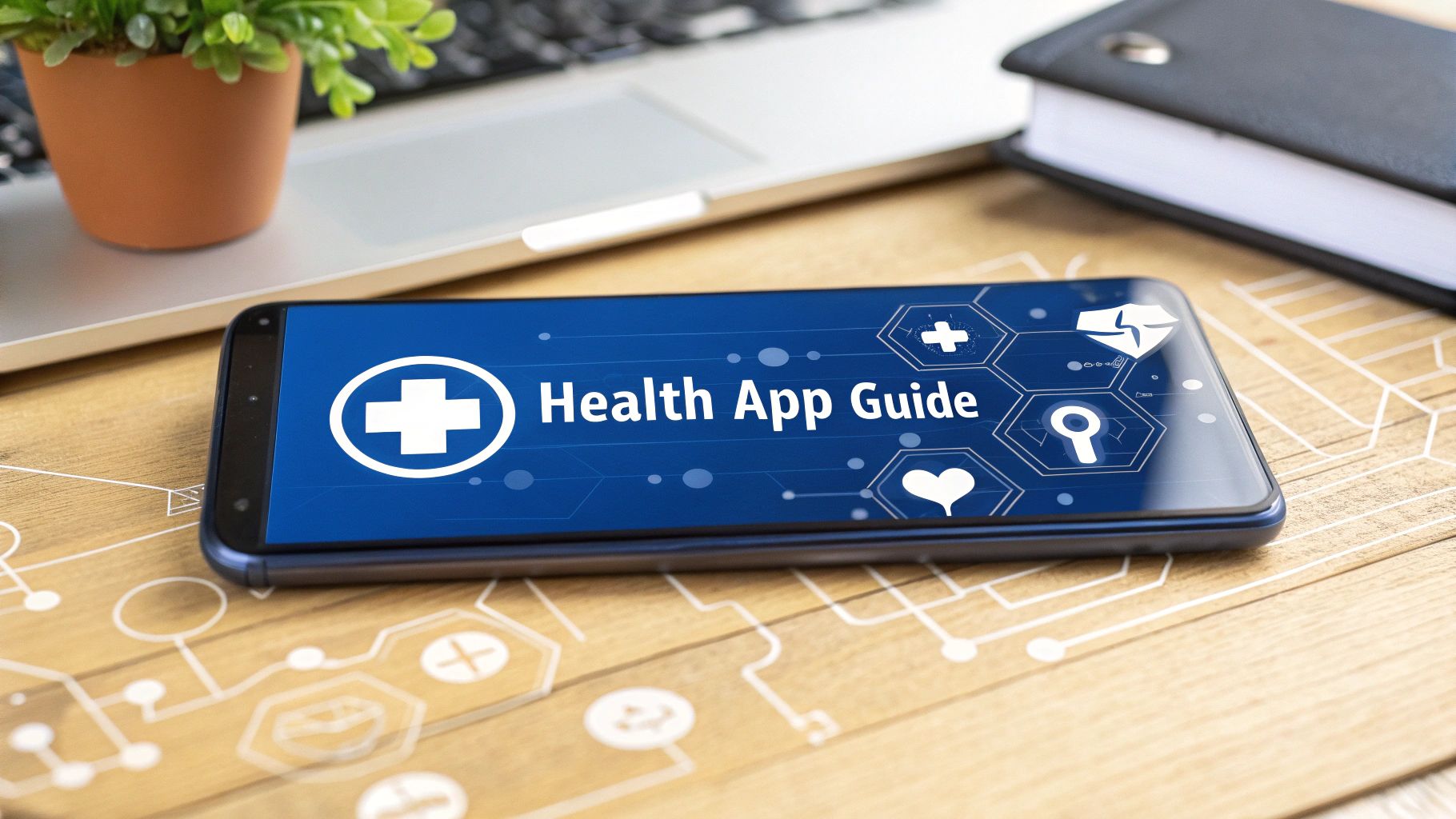Picture a healthcare system that doesn’t just react to illness but actively predicts it, creating treatments tailored to your specific genetic makeup. That’s the incredible potential of AI in medtech, a powerful combination that is reshaping Canadian healthcare from the ground up. Think of it as a brilliant co-pilot for clinicians, one that can sift through millions of data points to spot patterns a human might miss.
The New Digital Frontier in Canadian Healthcare
As our healthcare system grapples with ever-increasing pressures, this kind of technological shift is a present-day reality. Weaving artificial intelligence into medical devices and software is quickly becoming the new gold standard for patient care. It’s all about making healthcare smarter, quicker, and far more personalized for every single Canadian.
This move from traditional, often manual, methods to intelligent, data-driven systems marks a major turning point for the industry. It means using complex algorithms to improve everything from the accuracy of diagnostic tools to the effectiveness of patient monitoring systems. This guide will show you exactly how this change is playing out across the country.
Driving Forces Behind MedTech’s AI Adoption
So, why the sudden surge? Several key factors are pushing AI into the medical technology spotlight. Getting a handle on these drivers makes it clear why this is happening now and what it means for the future of patient care.
- The Push for Precision Medicine: Instead of a one-size-fits-all approach, AI can analyze genetic data, lifestyle choices, and clinical history to help create highly customized treatment plans.
- Massive Leaps in Computing Power: The rise of powerful cloud computing and specialized processors has finally made it feasible to train sophisticated AI models on the enormous datasets that healthcare generates.
- The Need for Better Efficiency: Hospitals and clinics are always under pressure to do more with less. AI steps in to automate repetitive tasks, streamline clinical workflows, and make resource management far more effective.
The infographic below really brings to life how these AI-powered analytics are creating a new kind of digital command centre for modern healthcare.
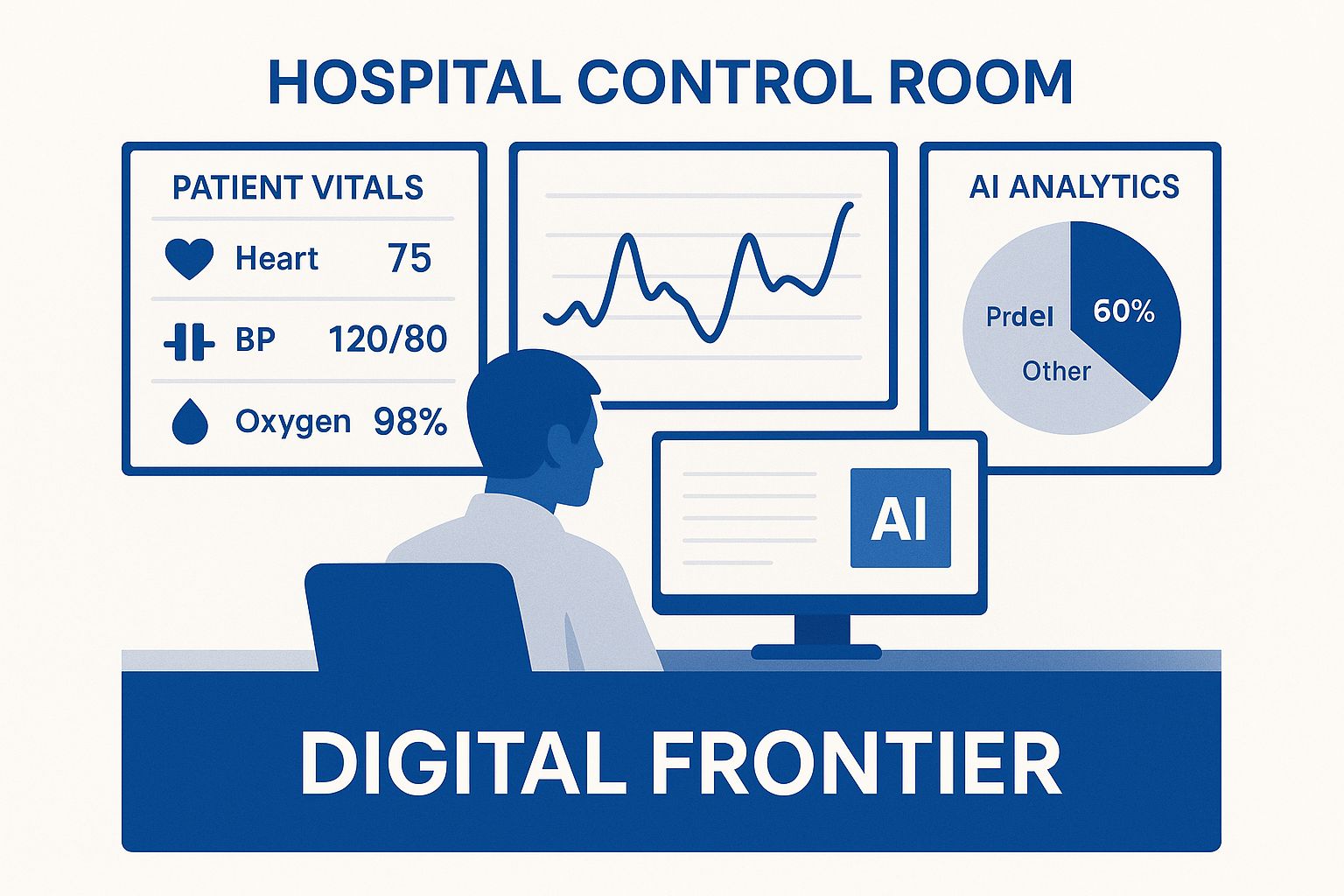
This visual shows the incredible intersection of real-time patient data and predictive analytics: a combination that is central to the future of how hospitals operate. To make the most of these new capabilities, having a solid Healthcare software development service is non-negotiable for building the digital backbone these intelligent systems rely on.
At its heart, the goal of AI in MedTech is to give healthcare professionals better tools to work with. It’s about augmenting human expertise, not replacing it. The result? Earlier diagnoses, more effective treatments, and ultimately, better health for all Canadians.
This journey is about more than just plugging in new technology; it demands a thoughtful strategy for implementation. As we’ve discussed in our post on AI solutions for hospitals in Canada, getting it right depends on careful planning and a true partnership between tech experts and medical professionals. This synergy is the key to navigating the complex worlds of both healthcare data and clinical practice. Expert AI development services are essential for turning this potential into practical, life-saving applications. At Cleffex, we’re proud to be at the forefront of this progress.
How AI is Sharpening Medical Diagnostics
Of all the places AI is making its mark in medtech, medical imaging and diagnostics might be the most profound. Think of AI in this context as a highly trained specialist with a nearly perfect memory. It can reference and compare millions of medical scans in an instant to spot irregularities so subtle they might otherwise go unnoticed. This is completely changing how clinicians approach the detective work of disease detection.
Machine learning algorithms are now being trained to analyze X-rays, MRIs, and CT scans with a level of precision that serves as an incredible complement to human expertise. These systems learn from vast, anonymized image libraries, becoming experts at identifying the faint whispers of disease long before they become a roar.
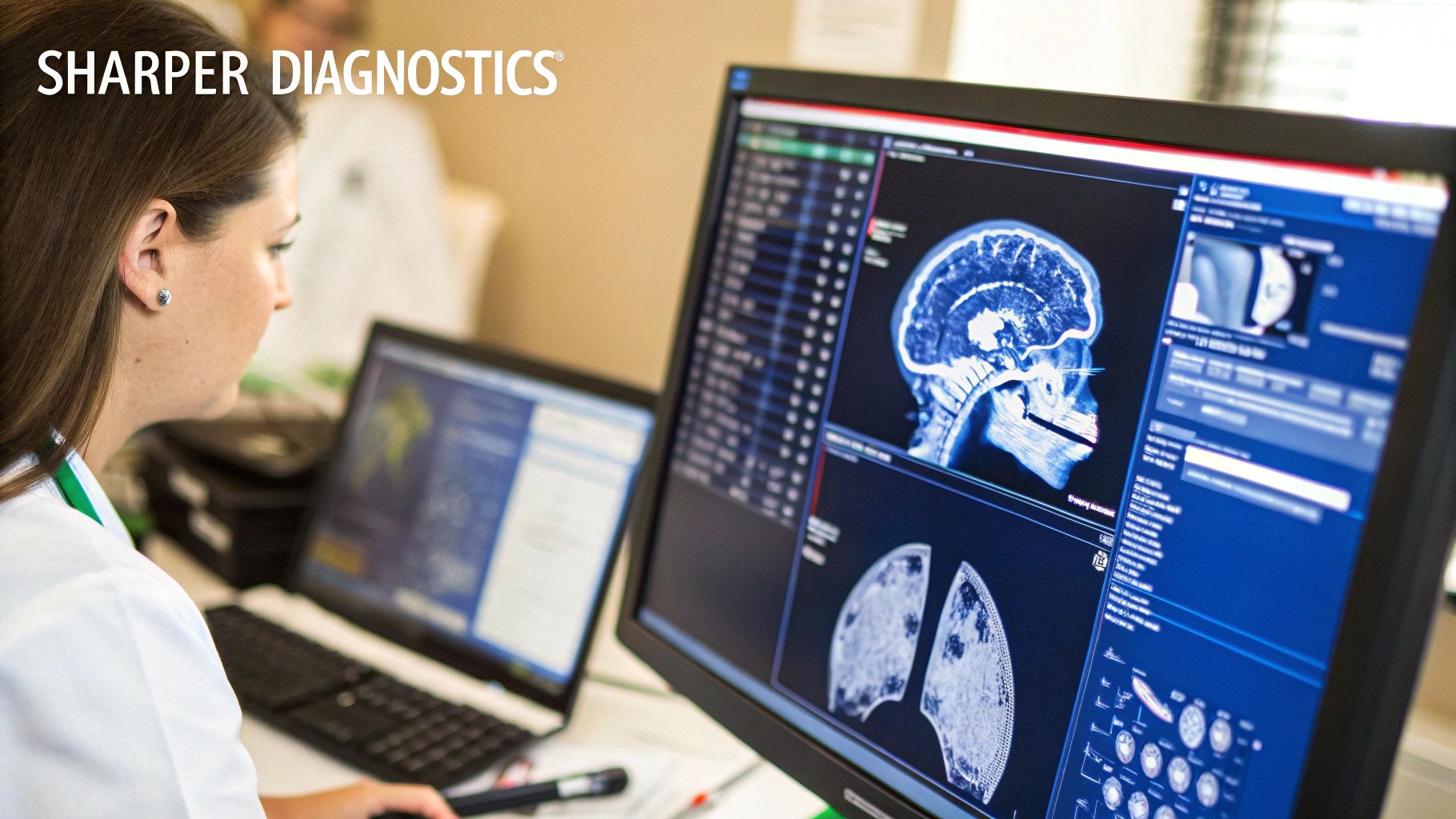
A technology like computer vision, for example, acts like a radiologist who never needs a coffee break. It meticulously scans every single pixel of an image, flagging anything that looks out of the ordinary for a human expert to review. This kind of tireless support helps lighten the immense workload on medical staff, freeing them up to focus on what matters most: complex cases and direct patient care.
Real-World Diagnostic Breakthroughs
This isn’t just theory anymore; the promise of AI is already delivering tangible results in clinics. Right here in Canada, healthcare providers are witnessing firsthand how these tools can trigger earlier interventions and lead to drastically better outcomes for patients. As we explored in our AI in healthcare adoption guide, this trend is rapidly accelerating.
A few powerful examples are already in action:
- Diabetic Retinopathy: AI algorithms can scan retinal images to find the earliest signs of diabetic retinopathy, a leading cause of blindness, often with more accuracy than initial human screenings.
- Oncology: In lung cancer screening, AI models are spotting tiny, potentially cancerous nodules on CT scans that are incredibly easy to miss, allowing treatment to start at a much earlier, more survivable stage.
- Neurology: When looking at brain MRIs, AI is helping to detect subtle changes linked to conditions like Alzheimer’s or multiple sclerosis, giving doctors crucial data for diagnosis and monitoring.
By the end of 2025, it’s projected that AI-assisted diagnostics will show accuracy rates exceeding 90% in certain imaging fields, a leap forward that is already improving outcomes for thousands of Canadians.
The real magic of AI in diagnostics isn’t about replacing clinicians. It’s about augmenting their skills. This creates a powerful collaboration, blending the machine’s analytical power with a doctor’s deep contextual understanding and years of experience.
A New Standard of Diagnostic Care
The advantages of weaving AI into diagnostic workflows are becoming crystal clear. This isn’t just a minor upgrade; it’s a fundamental shift toward a more data-driven, precise, and efficient standard of care.
To see just how different the approach is, it helps to compare the old and new ways of working side-by-side.
AI-Powered Diagnostic Tools vs Traditional Methods
| Feature | Traditional Diagnostic Methods | AI-Powered Diagnostic Tools |
|---|---|---|
| Speed | Can be time-consuming, depending on caseload and complexity. | Rapid analysis of images and data, often in seconds or minutes. |
| Accuracy | Reliant on human expertise, which can be affected by fatigue or bias. | Highly consistent with the ability to detect subtle patterns that humans might miss. |
| Scalability | Limited by the number of available specialists. | Can process thousands of scans simultaneously, addressing workforce shortages. |
| Objectivity | Subject to inter-observer variability and individual interpretation. | Provides standardized, quantitative assessments based on learned data patterns. |
As you can see, AI tools offer more than just a simple improvement; they represent a significant leap forward. By providing a faster, more consistent “second opinion,” these systems empower medical professionals to make decisions with greater confidence. This is where a robust healthcare software development service becomes essential, creating the backbone needed to integrate these advanced tools into the clinics and hospitals where they can do the most good.
Accelerating Drug Discovery and Personalized Medicine
Beyond just finding diseases, AI is changing the very foundation of how we create cures. The traditional path to discovering a new drug is a marathon, a slow, expensive grind that can easily take more than a decade and cost billions of dollars. But by integrating AI into medtech, we’re starting to flip that script, turning the research lab into a hub of rapid, data-driven innovation.
Think of AI as a brilliant molecular matchmaker. It can dive into massive databases packed with biological and chemical data, analyzing how millions of potential drug compounds might interact with a specific disease at the cellular level. This predictive muscle lets researchers pinpoint the most promising candidates for development far quicker than was ever possible with manual methods.
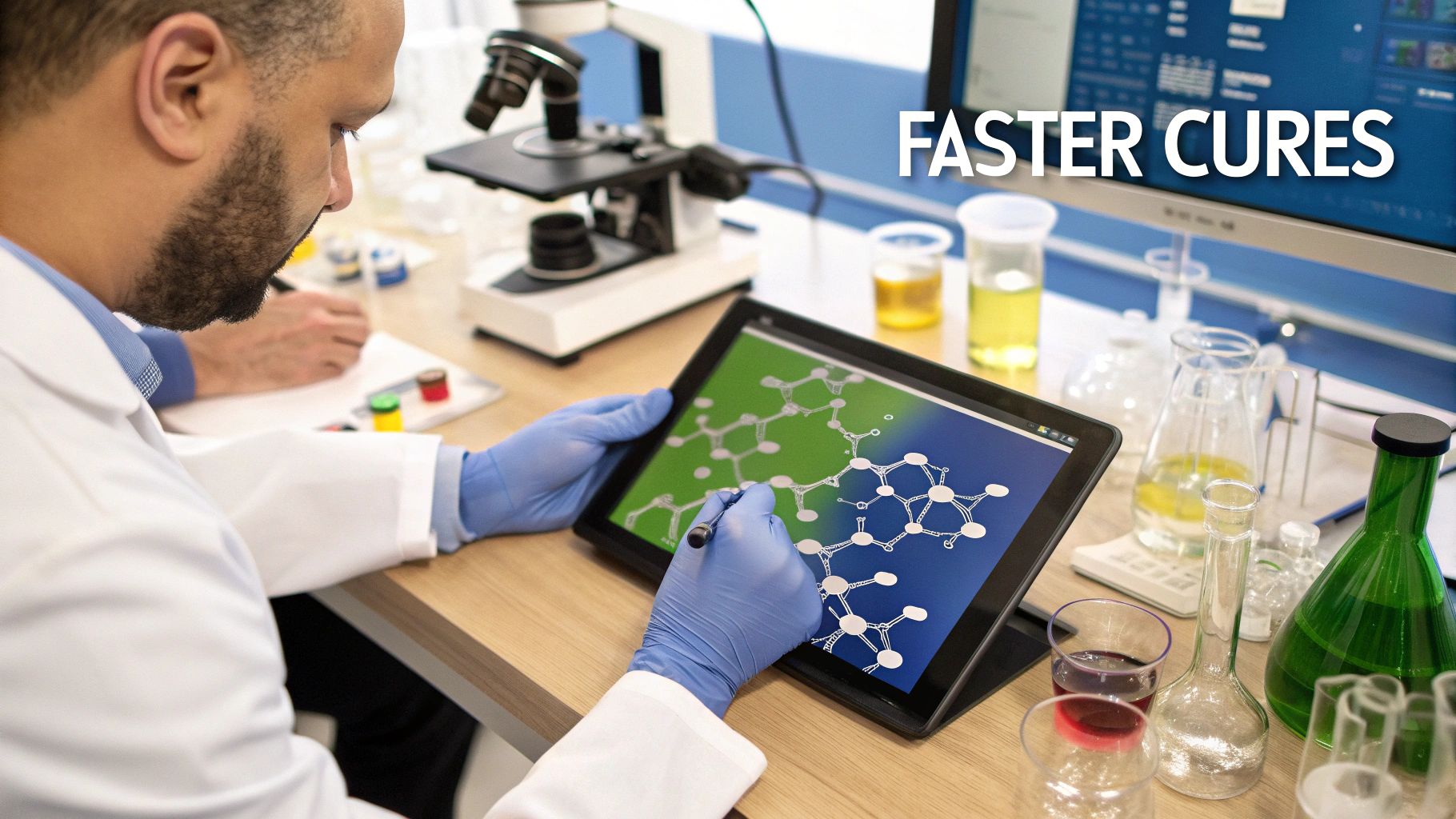
This speed isn’t just about saving time; it’s about saving crucial resources. By running digital simulations, AI helps weed out compounds likely to fail early on. This allows pharmaceutical companies to pour their time, energy, and funding into the candidates with the best shot at actually working.
From the Lab to the Clinic
AI’s influence doesn’t stop once a drug is developed. It’s moving directly into patient care through the rise of personalized medicine, a concept that’s turning the old one-size-fits-all treatment model on its head. The goal is to create healthcare plans that are as unique as the person receiving them.
This is a job tailor-made for AI algorithms. They can make sense of a complex web of patient-specific data, including:
- Genetic Information: Pinpointing specific biomarkers in a person’s DNA that can predict their response to a certain drug.
- Lifestyle Factors: Factoring in diet, exercise, and environmental exposures that all play a role in health outcomes.
- Clinical History: Weaving together past medical records and diagnostic results to see the full picture of a patient’s health.
By crunching all this information, AI helps clinicians predict which treatments will work best and cause the fewest side effects for a specific individual. This is where a custom Healthcare software development service is essential, building the platforms needed to manage all this data and deliver these highly specific insights right where they’re needed: at the point of care.
Personalized medicine, powered by AI, transforms treatment from a guessing game into a precise science. It’s about delivering the right treatment to the right patient at the right time, a level of customization that was once considered science fiction.
Crafting Bespoke Treatment Plans
We’re already seeing the practical results of this personalized approach. In oncology, for example, AI can analyze a tumour’s genetic makeup to recommend targeted therapies that are far more effective than standard chemotherapy. For chronic illnesses like diabetes, it can help create dynamic management plans that adjust in real-time based on data from wearable sensors.
Of course, this shift demands a new kind of digital backbone, one that can securely handle incredibly sensitive patient data and translate complex AI recommendations into clear, actionable advice for doctors. This is exactly why expert AI development services are so critical; they’re the ones building the bridge between raw data and better patient outcomes.
This move toward individualized care is a central pillar of modern medicine, a topic we explored in our AI in healthcare adoption guide. The ability to craft bespoke treatment plans doesn’t just improve results; it also makes medicine safer by minimizing adverse reactions. By understanding each patient on a deeply biological level, AI is paving the way for a more effective and empathetic era of healthcare.
Navigating the Ethical and Regulatory Maze
With the incredible power of AI in MedTech comes an equally significant responsibility. As these intelligent systems become more woven into the fabric of Canadian healthcare, we have to face the complex ethical questions and regulatory hurdles head-on. The conversation is no longer just about “what can AI do?” but has shifted to “how should we do it safely and equitably?”
This means tackling tough issues, from safeguarding sensitive patient data to rooting out algorithmic bias. The real goal is to build a framework of trust where both clinicians and patients feel confident in the technology designed to help them. Without these crucial ethical guardrails, even the most brilliant innovations risk doing more harm than good.
The Critical Issue of Algorithmic Bias
One of the most persistent worries in the field is algorithmic bias. At its core, an AI model is only as smart or as fair as the data it learns from. If that data is skewed or simply doesn’t reflect the true diversity of the Canadian population, the AI can absorb and even amplify existing health inequities.
Think about it: an algorithm trained mostly on data from one demographic might struggle to accurately diagnose conditions in others. This isn’t a hypothetical problem. It could lead to real-world misdiagnoses or less effective treatment plans, accidentally creating a two-tiered system of care where technology only serves a select few.
True innovation in healthcare has to be inclusive. Ensuring fairness in AI isn’t just a technical challenge; it’s an ethical imperative. We must make sure new technologies reduce health disparities, not widen them.
This is precisely why we need robust frameworks for responsible AI. It means throwing our support behind ethical AI development initiatives that bake fairness and safety into the process from day one. The end game is to build systems that truly work for all Canadians, no matter their background.
Data Privacy in the Age of AI
Patient data is the lifeblood of healthcare AI, but it’s also profoundly personal and must be protected fiercely. The sheer volume of information needed to train a capable AI model, everything from genomic data to real-time health stats from a wearable device, creates massive privacy challenges.
Making sure this data is anonymized, stored securely, and used only for its intended purpose is non-negotiable. Canada has strong privacy laws, but the unique way AI operates demands that we constantly re-evaluate these rules to keep up. As we’ve covered before, navigating AI in healthcare data privacy in Canada is a complex but absolutely essential task for any organization working in this space.
Building a Strong Regulatory Framework
Regulators are working hard to draw clear lines for how AI in MedTech should be developed and rolled out. It’s a delicate balancing act: you want to encourage innovation while absolutely guaranteeing patient safety and the effectiveness of the device. This requires close collaboration between government bodies, tech companies, and healthcare providers.
A huge piece of this puzzle is creating transparent standards for how AI models are tested and monitored over their lifetime. Unlike a standard piece of software, AI systems can learn and evolve. That means they need ongoing oversight to make sure they stay safe and accurate.
This focus is being echoed at a national level. The 2025 Watch List from Canada’s Drug Agency specifically highlights the need to address the significant legal and ethical fallout from new AI technologies, calling out data privacy and potential bias. This proactive stance is essential if we want to build a sustainable future for AI in our healthcare system.
Ultimately, bringing AI into medical technology successfully demands a deep commitment to ethical principles. By openly confronting issues of bias, privacy, and regulation, we can build the foundation of trust needed for this powerful technology to reach its true potential. The path forward isn’t just about brilliant code; it’s about having a clear conscience.
The Future of AI in Canadian MedTech
Looking ahead, Canadian healthcare is on the brink of a fundamental change. We’re moving away from a model that simply reacts to illness and toward one that is proactive and preventative. This isn’t a gradual shift; it’s a leap forward, powered by the incredible potential of AI in MedTech.
The entire focus is expanding from just treating sickness to actively predicting and stopping it before it even starts. This is where AI truly comes into its own. Imagine public health officials forecasting a flu outbreak with the same precision as meteorologists predict a snowstorm. That kind of foresight allows for targeted, life-saving interventions, and it’s a reality intelligent systems are building right now.
The Dawn of Proactive Healthcare
One of the most tangible examples of this future is in AI-guided robotic surgery. These systems offer a level of precision and steadiness that even the most skilled human hands can’t match. The result? Less invasive procedures, quicker recovery for patients, and better overall outcomes. It’s like giving a surgeon an AI co-pilot that provides microscopic vision and flawless execution.
But the innovation doesn’t stop at the operating theatre. We’re also seeing the rise of empathetic virtual health assistants. These aren’t just chatbots; they’re AI companions offering 24/7 support. They can answer patient questions, monitor chronic conditions using data from wearables, and provide personalized health coaching, all of which help people stick to their treatment plans while giving clinicians a steady stream of real-world data.
These advancements are also driving serious economic growth. The Canadian medical technology market is projected to hit a revenue of US$13.29 billion by 2025, with medical devices leading the charge. While AI is set to completely reshape healthcare delivery, it’s worth noting that the regulatory side is still playing catch-up. To get a better handle on this, you can explore more insights into Canadian MedTech trends and regulations to see the full picture.
The ultimate goal is to build a healthcare system that anticipates our needs instead of just reacting to emergencies. AI is the engine that can crunch the enormous datasets needed to make this predictive, personalized vision a reality for every Canadian.
Canada’s Commitment to MedTech Innovation
Canada isn’t just watching this happen; it’s actively investing in this technological future. There’s a clear understanding that leadership in AI in MedTech is vital for both our economic health and the well-being of our citizens. This national commitment has created a vibrant environment for innovation, sparking collaborations between universities, tech start-ups, and healthcare providers. As we’ve discussed in our AI in healthcare adoption guide, a supportive ecosystem is essential for taking great ideas from the lab to the clinic.
Bringing these next-generation medical tools to life takes flawless execution. That’s where having a partner with deep technical expertise comes in. Our specialized AI development services are built to help MedTech companies harness these advanced capabilities and lead the way into this new era of medicine. By creating the right digital foundation with a robust Healthcare software development service, we help turn ambitious visions into life-saving solutions. To see the team and vision behind our work, feel free to visit our About Us page.
Building Your MedTech Future with the Right Partner
The journey into AI-driven healthcare is certainly complex, but it’s also filled with incredible potential. As we’ve seen, AI in medtech isn’t some far-off dream; it’s a real-world force that is already improving diagnostics, personalizing treatments, and accelerating medical discovery today. To make the most of it, you need a clear strategy and an experienced partner who gets both the technology and the strict demands of the healthcare sector.
Making this leap is essential for any healthcare organization that wants to stay relevant and deliver the best possible patient care. The right collaborator does more than just write code. They should be a strategic guide, helping you pinpoint where AI can make the biggest impact and ensuring any solution is secure, compliant, and ready to grow with you. This is how a great idea becomes a tangible, life-saving tool.
When you’re looking for a partner to develop or manufacture your next-generation medical technologies, it’s worth exploring companies with deep expertise across different specialties. For instance, those offering new approaches in additive manufacturing solutions for the medical market bring a unique perspective that covers the entire product lifecycle, from digital concept to physical device.
The key is to find a team that speaks both languages: the clinical language of patient outcomes and the technical language of machine learning. This dual fluency is what turns a promising project into a successful, real-world application.
Choosing Your Technology Ally
Finding the right fit means looking for a few specific qualities. Your ideal partner should have a proven track record in building secure platforms, as we explored in our AI in Healthcare Adoption Guide. They need to offer a comprehensive Healthcare software development service that can navigate the complexities of medical data and clinical workflows.
Ultimately, the goal is to put tools in the hands of clinicians that genuinely empower them and improve patient lives. This requires specialized AI development services that are capable of creating robust, ethical, and effective systems. To learn more about how we put these principles into practice, visit our About Us page to discover more about our team and our commitment to innovation.
Common Questions About AI in MedTech
It’s completely normal to have questions as artificial intelligence finds its way into more corners of medical technology. Let’s break down some of the most common ones to get a clearer picture of what AI in MedTech really means for patients, doctors, and the Canadian healthcare system as a whole.
Is AI Going to Replace My Doctor?
Absolutely not. The real goal here isn’t replacement, but partnership. AI is designed to be a powerful assistant, taking on the heavy lifting of data analysis, like poring over thousands of medical images or sifting through mountains of research. This frees up clinicians to do what they do best: focus on you, the patient.
Think of it as giving your doctor a super-powered co-pilot. The AI can crunch the numbers and spot patterns, but your doctor uses their years of experience, intuition, and empathy to make the final call on your care.
At its core, AI is there to support, not supplant. It handles the routine and the repetitive, so human experts can focus on the nuanced and the compassionate.
What’s Holding Back AI Adoption in Canadian Healthcare?
The biggest hurdles aren’t always about the technology itself; they’re often tied to the system. In Canada, we face complex regulatory pathways, strict patient data privacy laws, and the significant upfront cost of bringing these new systems online.
On top of that, there’s the massive technical challenge of getting new AI platforms to “talk” to the legacy IT systems already running in our hospitals. As we explored in our AI in healthcare adoption guide, we also have to tackle issues like algorithmic bias to ensure fair outcomes for everyone and, critically, build trust in these tools among both the medical community and the public.
How Can a Smaller Clinic Get Started with AI?
You don’t need a massive, hospital-wide overhaul to start benefiting from AI. For smaller practices, the key is to start small and be strategic. Focus on specific, proven tools that solve a real problem you’re facing today.
Here are a few practical starting points:
- Tackle the Admin Work: Use AI-powered software to automate patient scheduling, billing, and follow-ups. It’s a quick win that can immediately lighten the administrative load.
- Boost Diagnostic Power: Look into AI software that plugs into your existing imaging equipment. This can seriously enhance your diagnostic capabilities without needing a huge investment in new hardware.
- Improve Patient Communication: Simple, intelligent chatbots can handle routine patient questions and send out appointment reminders, freeing up your front-desk staff for more complex issues.
This approach lets your practice see the benefits firsthand, helps your team get comfortable with the new technology, and allows you to scale up as you grow. When you’re ready, working with professional AI development services can make all the difference. A skilled Healthcare software development service will ensure any new tool fits perfectly and securely into your current workflow.
Taking these measured steps can turn the promise of AI in MedTech into a practical advantage for any healthcare provider. To see the team that’s helping make this happen, check out our About Us page and learn more about our commitment to innovating healthcare.
